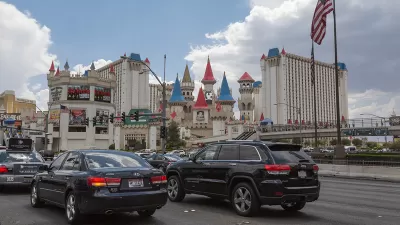2007 had set the prior record, which sparked the term, "peak miles driven" or "peak car." Historically low gas prices and an improved economy have fueled more driving, resulting in a record of 3.148 trillion miles driven last year.
There really was no surprise in the report from the U.S. Department of Transportation—the Feb. 22 press release just makes it official. The Federal Highway Administration (FHWA) 2015 monthly reports described here, such as April's and August's, had been indicating that 2015 would break the previous record set in 2007.
"New data released today by the U.S. Department of Transportation’s FHWA show that U.S. driving reached 3.148 trillion miles by the end of 2015, beating the previous record of 3.003 trillion miles in 2007," states the DOT's Feb. 22 press release.
The December 2015 “Traffic Volume Trends” report also includes seasonally-adjusted data, which is conducted by USDOT’s Bureau of Transportation Statistics as a way to even out seasonal variation in travel and enable (vehicle miles traveled) VMT comparisons with any other month in any year.
The press release was published in conjunction with the December 2015 travel report which shows that every region in the country saw travel increase from December 2014, setting a record for monthly travel. And the following data may give California Governor Jerry Brown (D), one of the most climate-conscious governors, some pause for how he expects to meet his ambitious greenhouse-gas emission targets. The Golden State saw record mileage increase in 2014 as well.
At 11.3 percent, California led the nation with the largest unadjusted single-state traffic percent increase compared to the same month a year earlier, followed by Hawaii at 7.2 percent and Arkansas at 6.2 percent. At 4.6 percent, Washington, D.C., had the largest unadjusted traffic single-month decrease.
NPR's David Schaper reports on the new data, noting the "downside to this resurgence of driving: increased traffic congestion and pollution." Listen here.
Why are we driving more? One reason is cheap gas. After spiking above $4 a gallon just a few years ago, gasoline prices have plummeted. According to AAA, the national average right now is just $1.71 a gallon, and in some states, gas is below $1.50.
He describes other reasons for the driving resurgence as well, and concludes by stating that "(s)ome transportation advocates say this new record level of vehicle miles traveled could help make the case for shifting away from the gas tax — and instead tax the number of miles we drive to fund highway improvements." A report from the Congressional Budget Office last month came to the same conclusion.
Which all goes to show, you can't believe everything you read, not even here. A Planetizen post in August 2014 titled "Five Reasons Why Peak Driving is Here to Stay" clearly didn't foresee how low gas prices would plummet, and the profound effect on VMT they would have.
Note that FHWA did not report on driving per capita or per household.
Hat tip to AASHTO Journal.
FULL STORY: U.S. Driving Tops 3.1 Trillion Miles In 2015, New Federal Data Show

Alabama: Trump Terminates Settlements for Black Communities Harmed By Raw Sewage
Trump deemed the landmark civil rights agreement “illegal DEI and environmental justice policy.”

Study: Maui’s Plan to Convert Vacation Rentals to Long-Term Housing Could Cause Nearly $1 Billion Economic Loss
The plan would reduce visitor accommodation by 25% resulting in 1,900 jobs lost.

Planetizen Federal Action Tracker
A weekly monitor of how Trump’s orders and actions are impacting planners and planning in America.

Wind Energy on the Rise Despite Federal Policy Reversal
The Trump administration is revoking federal support for renewable energy, but demand for new projects continues unabated.

Passengers Flock to Caltrain After Electrification
The new electric trains are running faster and more reliably, leading to strong ridership growth on the Bay Area rail system.

Texas Churches Rally Behind ‘Yes in God’s Back Yard’ Legislation
Religious leaders want the state to reduce zoning regulations to streamline leasing church-owned land to housing developers.
Urban Design for Planners 1: Software Tools
This six-course series explores essential urban design concepts using open source software and equips planners with the tools they need to participate fully in the urban design process.
Planning for Universal Design
Learn the tools for implementing Universal Design in planning regulations.
Caltrans
Smith Gee Studio
Institute for Housing and Urban Development Studies (IHS)
City of Grandview
Harvard GSD Executive Education
Toledo-Lucas County Plan Commissions
Salt Lake City
NYU Wagner Graduate School of Public Service



























